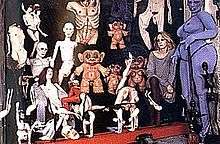Greer Lankton
| Greer Lankton | |
|---|---|
 Greer Lankton with some of her dolls | |
| Born |
1958 Flint, Michigan |
| Died |
November 18, 1996 (aged 37) Chicago, Illinois |
| Occupation | American artist |
Greer Lankton (1958 – November 18, 1996) was an American artist known for creating lifelike, sewn dolls that were often modeled on friends and celebrities and posed in elaborate theatrical settings. She was a key figure in the East Village art scene of the 1980s in New York.
Early life
Greer Lankton was born in Flint, Michigan, to a Presbyterian minister and his wife.[1] It was during her rough childhood as a feminine boy that she began creating dolls. "It was when I was about ten years old ... I used to make dolls out of hollyhocks and all types of flowers. Pipecleaner dolls and things like that. I started taking it seriously by the time I went to college when I was 17."[2] Greer was often teased by peers, and on more than one occasion experienced physical harassment.
Lankton studied at the Art Institute of Chicago and later Pratt Institute in New York.[1] She changed her name and had sexual reassignment surgery at the age of 21, while she was a student at Pratt.[3] She had previously been the subject of a local newspaper article about people transitioning to a new gender.
Work
Gender and sexuality are recurring themes in Lankton's art. Her dolls are created in the likeness of those society calls "freaks", and have often been compared to the surrealist works of Hans Bellmer, who made surreal dolls with interchangeable limbs. She created figures that were simultaneously distressing and glamorous, as if they were both victim and perpetrator of their existence.
In 1981 Lankton was featured in the seminal "New York/New Wave" exhibition at P.S.1 in Long Island City, and began to show her work in the East Village at Civilian Warfare. She gained an almost cult following among East Village residents from her highly theatrical window displays she designed for Einstein's, the boutique that was run by her husband, Paul Monroe, at 96 East Seventh Street.[3]
Besides her more emotionally charged dolls, Lankton also created commissioned portrait dolls. These include a 1989 doll of Diana Vreeland that was commissioned for a window display at Barney's[3] as well as shrines to her icons, such as Candy Darling.
Critic Roberta Smith described her works in the New York Times as: "Beautifully sewn, with extravagant clothes, make-up and hairstyles, they were at once glamorous and grotesque and exuded intense, Expressionistic personalities that reminded some observers of Egon Schiele. They presaged many of the concerns of 90's art, including the emphasis on the body, sexuality, fashion and, in their resemblance to puppets, performance."[1]
Photographer Nan Goldin said of her work, "Greer was one of the pioneers who blurred the line between folk art and fine art."[4] She had spots in the prestigious Whitney Biennial and the Venice Biennale, both in 1995, where her busts of Candy Darling, circus fat ladies, and dismembered heads gained her notoriety.[5][6]
In November 2014, "LOVE ME," a major exhibition of Lankton's work including more than 90 dolls, documentation, and ephemera, was mounted at PARTICIPANT, INC in New York City. It was organized by Lia Gangitano in cooperation with G.L.A.M., the Greer Lankton Archives Museum, which was founded by Paul Monroe after her death.[3]
Personal life
Greer was friends with photographer Nan Goldin, and lived in her apartment in the early 80's, often posing for her. She also played muse to photographers like David Wojnarowicz and Peter Hujar.
It was in New York in 1982 that she met artist Paul Monroe. They quickly became inseparable, and she moved into his apartment and started working in his shop, Einsteins. Her next solo featured a number of portrait dolls, including one of her and Paul in bed (à la Yoko and John). Greer and Paul married in 1987. Teri Toye was the bridesmaid, Nan Goldin took the wedding photos, and Greer’s father was the minister.
Lankton struggled with drug addiction and anorexia for many years, eventually becoming sick. She died on November 18, 1996 of a drug overdose in her Chicago apartment, just a month after completing her final and largest work titled "It's All About Me, Not You", which has become a permanent installation at the Mattress Factory in Pittsburgh. Lankton had one protégé, Jojo Baby, who continues to make dolls in Chicago.
References
- 1 2 3 Smith, Roberta (November 25, 1996). "Obituaries: Greer Lankton, 38, a Sculptor Who Turned Dolls Into Fantasy". New York Times. Retrieved 1 November 2014.
- ↑ greer4
- 1 2 3 4 Fateman, Joanna. "500 Words: Lia Gangitano discusses Greer Lankton". Artforum.com. Retrieved 1 November 2014.
- ↑ Goldin, Nan (October 1999), "Nan Goldin on Greer Lankton", ArtForum, retrieved 2007-10-18
- ↑ "The Mattress Factory Art Museum: Home -> Exhibitions -> 1996 -> Greer Lankton". Retrieved 2007-10-18.
- ↑ Morton, Julia (2007-01-26). "Greer Lankton, A Memoir". Artnet. Retrieved 2012-03-13.